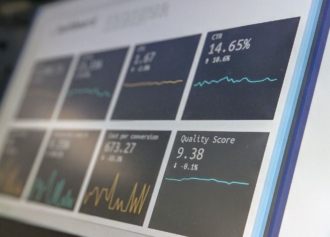In the 1960s, the Herman Miller furniture company created a design tool that revolutionized corporate aesthetics for decades to come. You guessed it — the standard cubicle.
The cubicle was more than just four grey walls. It came to represent shrewd management economics (squeezing as many employees as possible into a workspace) and a general ambivalence about creating places where staff enjoy coming to work.
Considering the long hours that many people clock at the office, you’d think we’d put more effort into creating aesthetically pleasing workspaces.
But that hasn’t been the case — until recently.
The rise of modern workplace design
Tour the corporate headquarters of modern companies like Instagram and Bumble, and it’s clear that times are changing. Once the cubicle walls came down, the impersonal office opened up to a whole new world of creative design.
As I recently wrote in “Why open office design makes you less productive”, office design also reflects a company’s values.
Walk into a modern office with a coffee lounge in the reception area, and a mix of open space and private rooms, and instantly you get the sense of a forward-thinking company. Visit a sea of cubicles where the higher-ups are camped out in swanky corner offices, and you’re instantly transported to the 1999 film, Office Space.
Since founding Jotform in 2006, we’ve dabbled in different office designs and we figured workplace design isn’t just a matter of brand identity; it also affects employee creativity, productivity, satisfaction, and even health.
The truth is if you examine some of the most successful and appealing workplace designs, architects and interior designers often use many of the same techniques.
Some are simple updates to liven up the space, while others require a deeper dive into your company’s specific needs. Before you redesign your whole office, here are a few universal rules of thumb:
1. Let there be (natural) light
Natural light is the most fundamental element of a welcoming space.
In a poll of 1,614 North American employees, researchers found that access to natural light and views of the outdoors were the most desirable attribute of a workplace environment, outranking features like onsite cafeterias, fitness centers, and daycare.
Aside from employee preferences, natural light not only improve health and wellness among workers; it also has been shown to encourage creativity.
It’s no surprise that great artists like Cezanne, Picasso, and Van Gogh chose the sun-bathed, natural splendor of Provence as the backdrop for their iconic paintings. I truly believe that connecting with light and nature sparks our innermost creativity.
Said Frank Lloyd Wright, the prolific American architect,
“Study nature, love nature, stay close to nature. It will never fail you.”
Which leads to another important element: plant life.
2. Add in the green
There are many good reasons to add some flora to your office space. For example, office plants have been proven to lower workplace stress and increase productivity. People who work in offices with leafy green plants concentrate better than those who work without greenery.
Though an indoor forest a la Facebook would be nice — their office “Town Square” is a sheltered green space with 40-foot-tall redwood trees — research has shown that even a few desk plants can boost concentration.
And desk plants plus a window out to nature? Even better.
Bringing plant life into the office has solid health benefits, too. Researchers have found that reconnecting workers with the natural environment results in fewer sick days. And it goes without saying, healthier workers are happier workers.
Employees who work in plant-filled offices also report better air quality. In addition to making employees more comfortable, one Harvard study showed that improving air quality caused dramatic increases in mental cognition.
On the other hand, poor ventilation raises carbon dioxide levels, which studies have shown can impair cognitive performance and dampen the mood.
If adding some plants to the office will give my team both a brain and a mood boost, then show me the way to the nearest greenhouse. (Pro tip: you can even order plants and seeds from Amazon’s online greenhouse.)
3. Consider your company’s unique needs
Office design should always take your company’s workspace needs into consideration. For example: how do your teams work best? What are their physical and technological needs?
One architecture and design firm came up with a list of seven attributes to consider when determining your optimal workspace: location, enclosure, exposure, technology, temporality, perspective, and size.
Using this index, HLW International redesigned Adobe’s New York office to create a more transparent space that still maintained activity-based boundaries. Similarly, Yodle’s New York headquarters were reimagined to incorporate both small, private spaces for focused work and airy places for large gatherings.
I was equally impressed when I read about the new NYC headquarters of Shake Shack, the fast-casual burger chain with a cult following. Not only do they offer modern amenities including a cozy lounge and a quiet room, but the office also has a fully-functional innovation kitchen.
For Shake Shack, which is dedicated to culinary innovation, this feature makes perfect sense. But of course, that’s specific to their company needs.
Sometimes it’s tempting to imitate another company’s design success but remember: one size does not fit all.
4. Offer various types of workspaces
As I recently explained, open office designs can be challenging, but some open space is a good idea.
Providing a mix of multiple workspaces, including open space, has been shown to improve employee engagement because people can choose the right area for the task at hand.
According to a June 2017 Gallup news story,
“Employees who have the ability to move to different areas at work are 1.3 times more likely to be engaged than other employees.”
For example, you can offer a living room area with comfy couches, as well as a library area for reading and intense focus. Provide booths for private phone calls, as well as individual workstations or “home bases” for team members to set up shop.
Different spaces can eliminate design monotony — and create a workplace where employees actually want to spend their time every day.
5. Banish boxiness
I was surprised to learn that boxy cubicle shapes aren’t just bland; they can actually impair creativity. Round edges and circular design are said to put creatives subconsciously at ease, freeing up their minds for invaluable innovation.
Curved edges also inspire conversation, and allow for more organic movement among employees. That’s a good thing, given that coffee breaks and socializing with co-workers can leave employees feeling refreshed, productive, and, of course, happier.
6. Cut the corner office
In the corporate world of yesteryear, the corner office wasn’t just a space; it was a sign of status, reserved for partners and presidents. While leaders enjoyed sweeping views and luxurious comfort, lower-level workers typically toiled away in cramped, often windowless environments.
The startup world, however, has slashed this old-school hierarchy. Employees should be organized by function or team, rather than by status, which mixes the managers with the juniors; the new with the seasoned.
You never know when a spontaneous interaction will inspire your company’s next brilliant idea, so your office design should be as egalitarian as possible.
Personally, I love going for walks with new hires, so we can get to know each other better and I can hear their fresh ideas. Cutting the corner office also encourages an atmosphere where everyone is free to share, collaborate, and contribute fully.
7. Focus on (your employees’) feelings
This may sound obvious, but sometimes we forget the very people we’re designing our offices to support — our team members.
When employees identify with their workplace — or feel that the space aligns with their self-image and enhances their sense of belonging — they’re more likely to communicate with their peers and develop stronger connections to the company. And the best way to determine whether employees identify with the current workplace is to solicit their feedback.
A company should continually ask staff members how they feel about the office:
- Is it a place where they want to work?
- What would make it feel more comfortable and productive?
You can gather feedback through email surveys, informal meetings, and even suggestion boxes. However you ask, keep tabs on how closely your employees identify with their workspace and make updates as needed.
Love what you do — and where you do it
As the late Steve Jobs said, “Your work is going to fill a large part of your life, and the only way to be truly satisfied is to do what you believe is great work. And the only way to do great work is to love what you do.”
In the same vein, you’re going to spend a large part of your life at work. Ideally, you should love where you work — and try to create a space where your team feels at home, too.
Offering a workspace that incorporates natural elements and speaks to the needs of your employees is a valuable investment in your company.
Your teams will be healthier, more productive, more highly motivated, and they’ll develop a stronger connection to the company.
I’d say that’s worth all the potted plants you can fit in your office.
















Send Comment:
1 Comments:
More than a year ago
I loved Iron Age Office Funiture ( )!!!